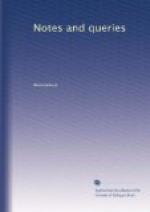Such is the story: I can answer for its general accuracy. I am quite at sea as to the meaning and orthography of “hipper switches,”—having heard, not seen, the story.
S.G.
Corpus Christi College, Cambridge.
* * * * *
THE COLLAR OF SS.
(Vol. ii., pp. 89. 194. 248.)
The Collar of SS. “is to this day a mystery to the most learned and indefatigable antiquaries,” according to Mr. Planche, in his valuable little work on The History of British Costume: what has appeared in “NOTES AND QUERIES” certainly has not cleared away the obscurity. ARMIGER tells us (Vol. ii., p. 195.): “As to the derivation of the name of the collar from Soverayne; from St. Simplicius; from the martyrs of Soissons (viz. St. Crespin and St. Crespinian, upon whose anniversary the battle of Agincourt was fought); from the Countess of Salisbury; from the word Souvenez; and, lastly, from Seneschallus or Steward, (which latter is MR. NICHOLS’ notion)—they may be regarded as mere monkish (?) or heraldic gossip.” If the monastic writers had spoken anything on the matter, a doubt never would have existed: but none of them has even hinted at it. Never having seen the articles in the Gentleman’s Magazine, I do not know MR. NICHOLS’ reasons for supposing “Seneschallus or Steward” could have furnished an origin of the SS.; but I am at loss to think of any grounds upon which such a guess could rest. From the searches I have made upon this question, it seems to me that these SS. are taken as a short way of expressing the “SANCTUS, SANCTUS, SANCTUS” of the Salisbury liturgy and ritual. I hope soon to be able to lay before the public the documents out of which I draw this opinion, in a note to the third and forthcoming volume of The Church of our Fathers.
D. ROCK.
Collar of SS.—To your list of persons now privileged to wear these collars, I beg to add her Majesty’s serjeant trumpeter, Thomas Lister Parker, Esq., to whom a silver collar of SS. has been granted. It is always worn by him or his deputy on state occasions.
THOMAS LEWIS,
Acting Serjeant Trumpeter.
34. Mount Street.
* * * * *
JOACHIN, THE FRENCH AMBASSADOR.
(Vol. ii., p. 229.)
Your correspondent AMICUS will I fear find very little information about this mysterious person in the writers of French history of the time. {281} He is thus mentioned in Cavendish’s Life of Wolsey (ed. 1825, vol. i. p. 73.):—




